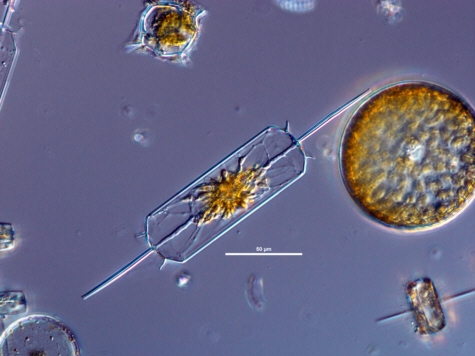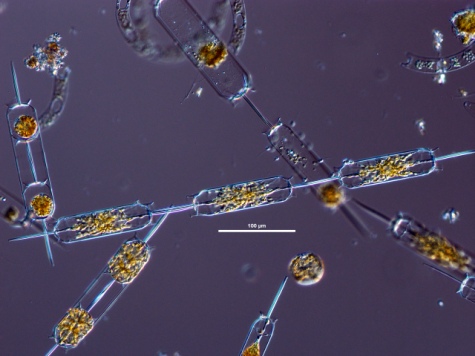



|



|
Synonym(s)
Heterotypic
A difference in type. In naming species, a heterotypic synonym is one that comes into being when a taxon becomes part of a different taxon. Compare to homotypic.
(heterotypic)Ditylum inaequale J. W. Bailey ex L. W. Bailey 1862 (heterotypic)
Triceratium brightwellii T. West 1860 Close
Basionym
The original name for an organism. In botany, the original published nomenclature from which a new binomial nomenclature is derived for a particular group of organisms (Tindall 1999).
(basionym, CloseHomotypic
Expressing the same fundamental type or structure; may or may not be symmetrical (e.g., the two valves of a diatom, where they are the same shape and appearance, but one is bigger than the other). In naming species, a homotypic synonym is one that comes into being when a taxon gets a new name (without being added to an already existing taxon).
homotypic)(Guiry and Guiry 2011)
Classification
(Guiry and Guiry 2011)
Lifestyle
Description
Girdle
In diatoms, the portion of the cell wall between the two valves of a cell; made up of intercalary bands (bands closest to the valves) and connecting bands (bands in the middle of the girdle). In dinoflagellates, the equivalent of a cingulum or transverse furrow (Horner 2002).
girdle view and roughly triangular in CloseValve
In diatoms, the structurally distinct halves of the cell wall (Becker 1996).
valve view. A large spine extends from the centre of each valve, and is surrounded by a CloseMargin
The outline or border that defines the shape of an organism or cell.
marginal ridge. Chains are connected by the large spines. Chloroplasts are small and numerous; CloseNucleus
(plural: nuclei) In eukaryotic cells, a membrane-bound organelle that contains the cell's genetic information; the nucleus controls the activities of the cell by controlling gene expression.
nucleus is central (Cupp 1943). Cells are yellow-brown in colour (Guiry 2011).Labiate process
In diatoms, a simple slit in the valve wall with two internal lips, one on each side of the slit. They can be useful in identification because they are positioned differently in different species (Horner 2002).
bilabiate processes; marginal ridge can be a ring of small CloseProcess
A natural projection or appendage on an organism.
processes called CloseAnsula(e)
In Ditylum and related diatoms, ansulae are the "fringes" seen near the ends of each cell. In SEM, you can see that each ansula is split into two ribbon-like points. A "single element of the fringed marginal ridge of Ditylum, shaped as a ribbon longitudinally split in its medium part" (Hasle and Syvertsen 1996).
ansulae, or a continuous membrane with multiple slots (Hasle and Syvertsen 1997). "The girdle zone is very long and not easily distinguishable from the valves. Scale-like CloseIntercalary bands
Girdle bands that are furthest away from the valve (Smithsonian 2011).
intercalary bands are visible with special treatment. Cell wall is weakly CloseSiliceous
Describing the character (i.e., white, shimmery) or chemical presence silicon dioxide (SiO2) as a component of phytoplankton cell covering.
silicified. Valves are CloseAreolated
Synonym: perforated. Describing a surface that has many holes. Often used to describe the valve surface of diatom frustules.
areolated- ClosePunctated
Marked with tiny coloured spots or depressions.
punctated, with areolae becoming more delicate toward the outside. A central area around the spine is structureless. Areolae are in CloseRadial
(symmetry) Describing a shape that many axes of symmetry. That is, it does not have a left and right like humans do (bilateral symmetry), but can be divided into equal halves no matter where you place the axis. Some examples of radially symmetrical organisms include sea stars and centric diatoms like Thalassiosira.
radial rows on valve surface, in ClosePervalvar axis
The axis through the centre point of the two valves of a frustule. This axis is perpendicular to the valve face.
pervalvar rows on valve CloseMantle
In diatoms, "the part of a valve that extends from the valve face, forming the valve edge." It is visible when the frustule is viewed in girdle view (Spaulding 2010).
mantle. The structure of the intercalary bands is similar but more delicate" (Cupp 1943).Measurements
Diameter: 14 - 120 μm
Valve areolae or Close
Ribs
Features that provide support to other structures in the cell.
ribs: 10 in 10 μmMantle areolae: 16 - 19 in 10 μm
(Cupp 1943, Kraberg et al. 2010)
Similar species
Harmful effects
Habitat
Distribution
Cosmopolitan except in polar regions (Hasle and Syvertsen 1997).
Blooms during spring around southern Vancouver Island (Ryerson et al. 2006), and during fall around the Bay of Fundy (Martin et al. 2008). Most abundant in spring and summer in Northern European seas, but occasionally present in small numbers throughout the year (Kraberg et al. 2010).
A south temperate species commonly found from the Gulf of California to the eastern Aleutian Islands, Alaska, though never in very large numbers (Cupp 1943).
Growth conditions
Nutrients
Various chemical substances that an organism needs for metabolism (i.e., to live and grow). These are usually taken up from the environment. Some examples include nitrate, phosphate, silica (for diatoms), iron, copper, etc. Some nutrients, like copper, are required for growth, but can also be toxic at high levels.
nutrient-rich waters (Hobson and McQuoid 2001). Cells are very sensitive to ClosePlasmolysis
The shrinking of the protoplasm away from the cell wall of an organism due to water loss from osmosis (when the cell has greater water pressure than its surroundings). This results in gaps between the cell wall and the cell membrane (Spaulding et al. 2010).
plasmolysis (Kraberg et al. 2010).Environmental Ranges
Temperature range (°C): -0.245 - 29.468
Nitrate (μmol L-1): 0.056 - 20.029
Salinity: 25.730 - 36.252
Oxygen (mL L-1): 4.500 - 7.859
Phosphate (μmol L-1): 0.048 - 1.656
Close
Silicic acid
A general term to describe chemical compounds containing silicon, oxygen and hydrogen with a general formula of [SiOx(OH)4-2x]n. Diatoms polymerize silicic acid into biogenic silica to form their frustules (Azam and Chisholm 1976).
Silicate (μmol L-1): 0.648 - 35.557(OBIS 2011, cited in EOL 2011)
Bloom characteristics
References
Cupp, E. E. 1943. Marine Plankton Diatoms of the West Coast of North America. University of California Press. Berkeley, California. 238.
Encyclopedia of Life. Ditylum brightwellii (T. West) Grunow. http://www.eol.org/pages/911826. Accessed 10 Jun 2011.
Gran, H. H. and Angst, E. C. 1931. Plankton diatoms of Puget Sound. Publications - Puget Sound Biological Station, University of Washington. 7: 417-519.
Guiry, M. D. (2011). Ditylum brightwellii (T. West) Grunow, 1885. http://www.marinespecies.org/aphia.php?p=taxdetails&id=149023. Accessed 10 Jun 2011.
Guiry, M. D. and Guiry, G. M. 2011. Ditylum brightwellii (T. West) Grunow. http://www.algaebase.org/search/species/detail/?species_id=37800. Accessed 10 Jun 2011.
Hargraves, P. E. 1982. Resting spore formation in the marine diatom Ditylum brightwellii (West) Grun. ex V. H. Proceedings of the Seventh International Diatom Symposium (D.G. Mann, ed). 33-46.
Hasle, G. R. and Syvertsen, E. E. 1997. Marine diatoms. In: Tomas, C. R. (ed.) Identifying marine Phytoplankton. Academic Press, Inc., San Diego, 5-385.
Hobson, L. A. and McQuoid, M. R. 2001. Pelagic diatom assemblages are good indicators of mixed water intrusions into Saanich Inlet, a stratified fjord in Vancouver Island. Marine Geology. 174: 125-138.
Horner, R. A. 2002. A Taxonomic Guide To Some Common Phytoplankton. Biopress Limited, Dorset Press, Dorchester, UK. 200.
Kraberg, A., Baumann, M. and Durselen, C. D. 2010. Coastal Phytoplankton: Photo Guide for Northern European Seas. Verlag Dr. Friedrich Pfeil, Munchen, Germany. 204.
Martin, J. L., Hastey, C. D., LeGresley, M. M. and Page, F. H. 2008. Temporal and Spatial Characteristics of the Diatom Ditylum brightwellii in the Western Isles Region of the Bay of Fundy. Canadian Technical Report of Fisheries and Aquatic Sciences. 2779: 26.
Ocean Biogeographic Information System. Ditylum brightwellii. http://www.iobis.org/mapper/?taxon_id=435735. Accessed 10 Jun 2011.
Ryerson, T. A., Newton, J. A. and Armbrust, E. V. 2006. Spring Bloom Development, Genetic Variation, and Population Succession in the Planktonic Diatom Ditylum brightwellii. Limnology and Oceanography. 51(3): 1249-1261.
